
The first part of this article ran in the 6 February issue of Dataweek.
Graceful degradation/error resilience
In general, higher compression will lead to more audio artifacts from a given level of stream errors. For example, the MPEG Layer II stream is more robust to stream errors than AAC streams.
A single-bit error in the spectral data part of Layer II would not make any annoying artifacts, as the spectral value maximum is decided by the bit-allocation value.
However, in the case of AAC, the same single-bit error would cause the Huffman decoder to fail and apply frame error concealment; repetitive frame errors will mute the audio until the error rate is reduced to a minimum. This long silence prevents the system from guaranteeing graceful degradation.
Error Resilience (ER) AAC coding guarantees graceful degradation from bit-stream errors with the help of these additional tools:
* HCR (Huffman codeword reordering): error propagation within spectral data is prevented by dividing the spectral data into fixed size segments. HCR places the most important data at the start of each segment.
* VCB11 (virtual codebooks for codebook 11): detects serious errors within spectral data with the help of special code word mapping.
* RVLC (reversible variable length coding): avoids error propagation in scale factor data.
The ER-AAC features, together with UEP, will provide adequate error resilience characteristics for DRM.
DRM specification
Digital Radio Mondiale (DRM) is an open standard from the European Telecommunication Standards Institute (ETSI) for digital narrowband audio for short- and medium-wave broadcasting.
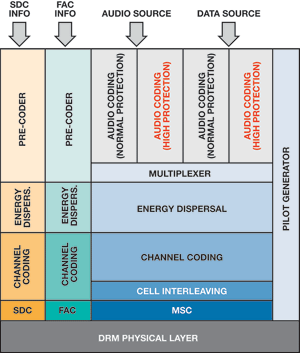
Although DRM supports bandwidths of 4,5 kHz, 5 kHz, 9 kHz, 10 kHz, 18 kHz and 20 kHz within four modes of transmission and reception, bandwidth and bit rate must be limited to 10 kHz and 24 Kbps, respectively, if compatibility with existing AM standards is desired.

This requirement demanded the use of highly efficient audio coding: Meltzer-Moser MPEG-4 HE-AAC v2 (International Standardisation Organisation/International Electrotechnical Commission - ISO/IEC) was a good choice, but the robustness against channel fading made an error-resilient version of HE-AAC v2 (Martin Wolters, 2003) the best choice.
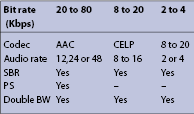
Besides AAC, the DRM standard defines the harmonic vector excitation coding (HVXC) and code-excited linear prediction (CELP) codecs to be used for transmitting speech. Streaming raw data for image slideshows, HTML pages and the like is also allowed by the DRM standard.
DRM architecture
A DRM system comprises three main transmission paths: main service channel (MSC), service description channel (SDC) and fast-access channel (FAC).
The FAC carries the orthogonal frequency-division multiplexed (OFDM) signal properties and the SDC/MSC configuration, and is limited to 72 bits/frame. The SDC contains the information needed for MSC decoding, such as the multiplex frame structure, and other information.
The MSC encodes the frame generated by the multiplexer. One can choose between standard mapping, symmetrical hierarchical or mixed hierarchical mapping. The MSC uses unequal error protection (UEP, Figure 6), in which the multiplex frame is split into two parts with different levels of protection: higher- and lower-protected data parts.
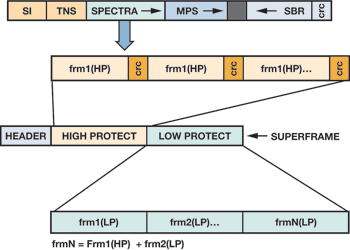
Digital radio with Blackfin
The Blackfin processor (Figure 7) is an excellent fit for operations requiring both digital signal processing and a microcontroller function. The ADSP-BF5xx family is particularly suitable for these applications and also offers a variety of peripherals.
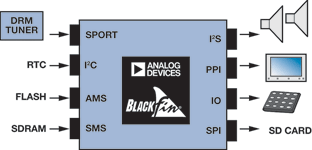
Availability of hardware and software development tools, several software components from third parties, and reference designs make it an ideal platform for multi-featured products. Multiple generations of products, availability of mature software IP from dependable sources, reliable support from Analog Devices, and the large portfolio of available high-performance analog integrated circuits support the quality of a designer’s end products.
Blackfin processor-based digital radios, Internet radios and multi-featured products can be created using the existing ecosystem that ADI created for these products.
In addition to creating the required ecosystem and sourcing the various software modules, ADI also created its own decoder libraries for digital radio. One such key component is an HE-AAC v2 decoder, which optimises the performance available from the large number of required MIPS.
Architecture of HE-AAC V2 decoder
HE-AAC v2 decoder components (Figure 8) combine to form the DRM source decoder. The MPEG-4 HE-AAC v2 decoder (which can support ETSI DAB and DRM standards) combines advanced audio coding (AAC), spectral band replication (SBR) and parametric stereo (PS). The decoder is backward compatible with AAC-LC.
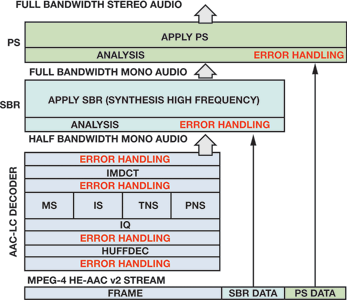
Key features include an MPEG-4 ER-AAC scalable decoder that can handle 960 samples per frame; AAC-LC/HE-AAC v1/v2/DRM/DAB support; error concealment support, DRC support; optimisation for memory and MIPS; and validation against a complete set of ISO/DAB/DMB and ETSI vectors.

The decoder implements all required audio coding tools specified by the standard, including:
* Higher frequency resolution and coding efficiency due to MDCT/TDAC.
* Adaptive block switching reduces pre-echo.
* Nonlinear quantisation.
* Huffman coding.
* Use of Kaiser-Bessel derived window function to eliminate spectral leakage.
* Variable frame size improves bit allocation.
* IS/MS stereo/TNS and PNS tools.
* Spectral band replication (SBR).
* Parametric stereo (PS).
Digital radio test results
A set of typical test results appears in Table 4.
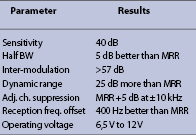
References
Feilen, Michael. 'The Hitchhikers Guide to Digital Radio Mondiale (DRM)'. The Spark Modulator, 2011.
Subrahmanyam, T.V.B., and Mohammed Chalil. 'Emergence of High Performance Digital Radio'. Electronics Maker, pp. 56-60, November 2012. www.electronicsmaker.com

© Technews Publishing (Pty) Ltd | All Rights Reserved